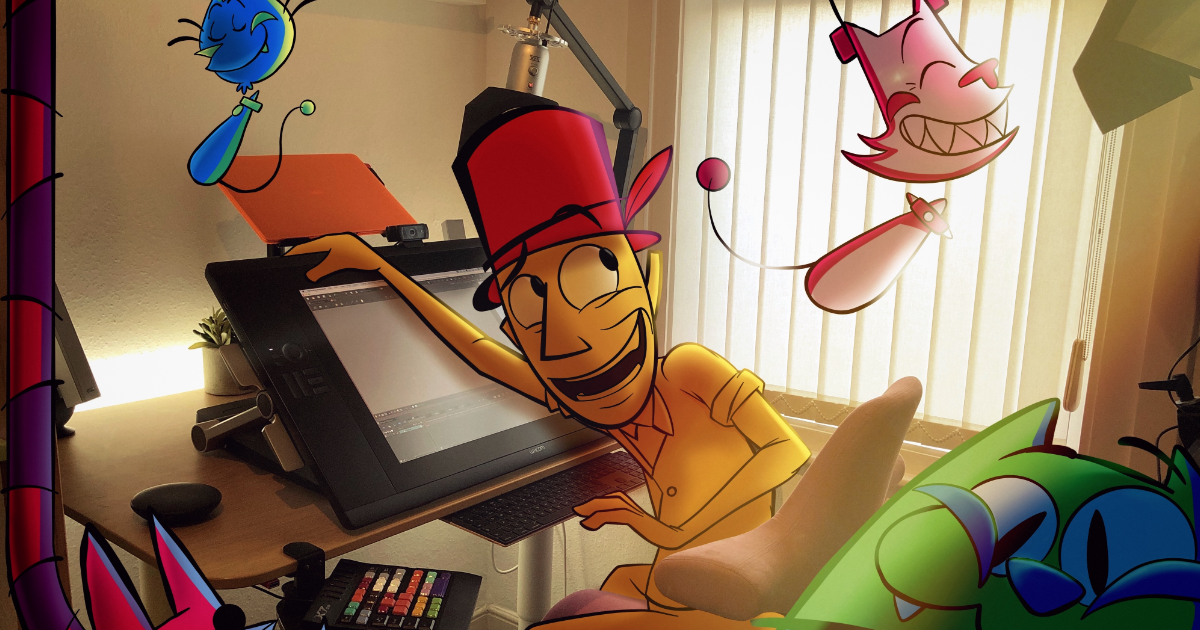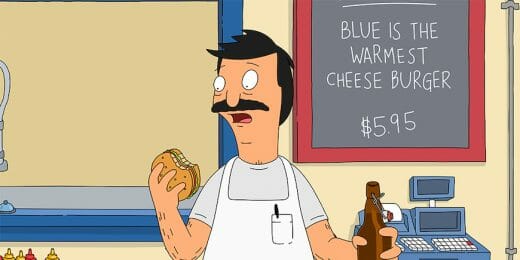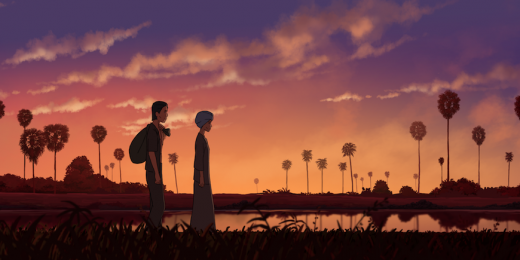
Oli Putland is a directing animator based out of Bristol, with over 20 years of experience across film, television and online video. His industry credits include work for Aardman Animations, Cosgrove Hall Films, Beano, and Sun & Moon Studios. Oli also publishes Cat Class POP! tutorials for his YouTube channel, which cover techniques for digital art and animation. We recently came across a rig he made for his channel, based on a character design from Harry Partridge’s STARBARIANS webseries, and invited Oli to talk about how he combines hand-drawn animation with modern rigging techniques.
Well… Here’s a finished bit of animation of @HappyHarryToons ‘ Killgar character made with @ToonBoom ‘s Master Controllers. There are a couple of things that if I were making it properly, I would do differently, but for the purposes of a tutorial…. Meh! Tutorial coming soon. pic.twitter.com/X31h2GQ3Oo
— Oli (@OliPutland) July 16, 2019
I noticed that you worked with stop-motion at Aardman Animations. How has that experience informed the way you animate in 2D?
Working with stop-motion is not essential to learning 2D animation, of course, but I definitely think my sense of weight and energy was enhanced through first working in this way. The unique thing about working with stop-motion is that you have a character that exists in real physical space. It actually weighs something and houses an armature that resists your movements. Itʼs a little hard to describe, but because of this resistance, you start to develop a sense of connection between your sense of touch and a characterʼs movement.
We wanted to talk to you about the work you did on Killgar’s Master Controller Rig. What drew you to working with this characterʼs design?
A few months ago, Harry asked me if such a rig was possible, so I accepted the challenge. I had worked with Harry before, so I felt comfortable playing with his characters. Despite his high standards, Harry is a relaxed sort of guy, so if any pressure was going to come from the project, it was going to be from me!
The second reason was that Killgarʼs design is complex and anatomically semi-realistic. Since STARBARIANS has such a strong fan base, I thought it would be great to explore new techniques and see if his audience would be on-board or not.
It was also ultimately a challenge to see if Harryʼs personal style of animation — traditionally-drawn stuff which takes quite a lot of time to produce — could be replicated with a more efficient working method in some way without losing Harryʼs style. It can sound horrible to make any form of art into a number-crunching game, but anyone who animates knows that unless you have a big budget, or a large crew, time impacts what you can produce.

What was your process for planning out this rig, and how long did it take you to put the rig together?
I cut my teeth on Master Controllers during my brief tenure as Lead Rigger at Sun & Moon Animation Studios. For the remake of the lost Doctor Who episode, The Macra Terror, we had a huge job making a large cast of human characters in a very short time frame. To get the level of expression needed for this kind of show, we used Master Controllers so that the animators could animate complex characters. In a relatively short space of time, we managed to produce one of the best Doctor Who animated shows ever made.
We were working with Harmony 15, and as the Master Controller technology was so new, we were developing techniques that had no parallel: some were abandoned, whereas others worked incredibly well. For me, Killgar was an attempt to re-examine some of these processes, as well as try the new features in Harmony 17. Planning the rig with 17 was much easier, not just because I was much more confident in my abilities, but also the program itself has ironed out many of the early creases. (Another noticeable difference is how much more CPU-efficient Harmony has become, which is a big boon for more complicated character rigs.)
Here’s an example of the speed of it: pic.twitter.com/jsLn8Azzd3
— Oli (@OliPutland) July 16, 2019
Based on the design you were working with, what challenges did you expect to run into, and how did you approach them?
The tricky stuff with any realistic head design is the eyes and the mouth. These are the elements that deform the most when the head turns to the extremes: left and right. Since I had only a set amount of time to play with, I dodged a bullet by not animating the mouth at all when it got to these extremes.
Killgarʼs eye design varies depending on his expression so, for the purposes of the tutorial, I chose a circular eye pose which doesnʼt deform at the extreme angles. Rigs I designed recently, with the new Stack Wizard and Free Form Deformations in Harmony 17, have allowed me to develop really complicated stuff both easier and with many more options available than we had in previous versions. If Harry wanted me to develop the Killgar rig into something more robust (and we have talked about it), I would not be phased about where to go and what I would have to do.
Once you had the basics down, what did you do to further refine this rig?
As Master Controller rigs go, this one is actually quite simple. It only has one control: The head orientation. The refinement comes from hand drawn eye blinks and mouth poses, created as drawing substitutions, which gives it a more hand-made quality. Ultimately the animation took about 2 hours for the sequence that is shown at the end of the video, a fraction of the time it would have taken if it had been entirely hand animated.
How would you describe the response to the Killgar’s Master Controller Rig, from both Harry Partridge and the broader community?
Harry was blown away. He had already seen Rapunzel’s Tangled Adventure and The Lion Guard from Disney Television Animation and was familiar with these new-fangled techniques coming onto the scene, but Iʼm guessing they have an army of programmers at their disposal to create in-house scripts which are unique to them. Itʼs only recently through the Master Controller Wizards you guys developed that individual creatives can now attempt this brand-new animation technique. Itʼs very exciting. People are shocked that it isnʼt hand drawn, and want to figure out how they can get their creations moving in this more sophisticated manner.
I am blown away…this is making me seriously consider what I’m even doing.
— Harry Partridge ⚡️ (@HappyHarryToons) July 16, 2019
You managed to condense the entire process for building this rig into a 12-minute tutorial for your YouTube channel. What was your approach to putting this tutorial together, and who was your intended audience?
The point of my Cat Class POP! tutorials is more about inspiring people to have a go, than actually showing you how to do everything. So many tutorials that I see online have a dry, sleepy quality to them that can turn people off — especially if itʼs complicated. I never made a POP! video for such an involved process before, but I gave it a go.
People seem to like it, even if theyʼre not interested in actually making a rig at all. I suppose itʼs a bit like cookery shows where you watch and get enjoyment from the process even if you have no intention of creating a soufflé or baking a cake.
You mentioned on Twitter that you see Master Controllers as an animation aid rather than a replacement. What advice do you have for animators who are just starting to work with this new style of 2D rigs?
My advice is to keep it simple and prioritize the animatorʼs needs. This is the case when developing any kind of armature: Physical or virtual. For example: If you havenʼt built a bending mechanism into the character, the character canʼt bend!
Having said that, while it is tempting to build a rig that can do everything (react to gravity, apply inverse kinematics to the arms and legs, change its shading based on environment, etc.) the problem is that the more a rig can do, the more it can potentially inhibit an animatorʼs process. The risk is too much automation can slow animators down more than if they did some of the work manually. Itʼs a constant struggle of rig complexity over animation simplicity which often need to be refined together. The rigger reacts to the animators needs, and vice versa.
Regarding the master controller, I have this to say: All the master controller does is move things around in a way which, if you had the time, you could do manually. It does the hard graft for you, but it’s not magic. It just seems magical when it does the job so well.
Getting there with @HappyHarryToons ‘ Killgar test character. I think the key to Master Controllers is to accept them more as an animation aid, rather than a replacement. Much more efficient, and easier to tweak. #Killgar #ToonBoom #Harmony17 #MasterController pic.twitter.com/Dj1c2F0o9j
— Oli (@OliPutland) July 9, 2019
Interested in seeing more of Oli Putland’s work? Be sure to follow Oli on Twitter and YouTube.



